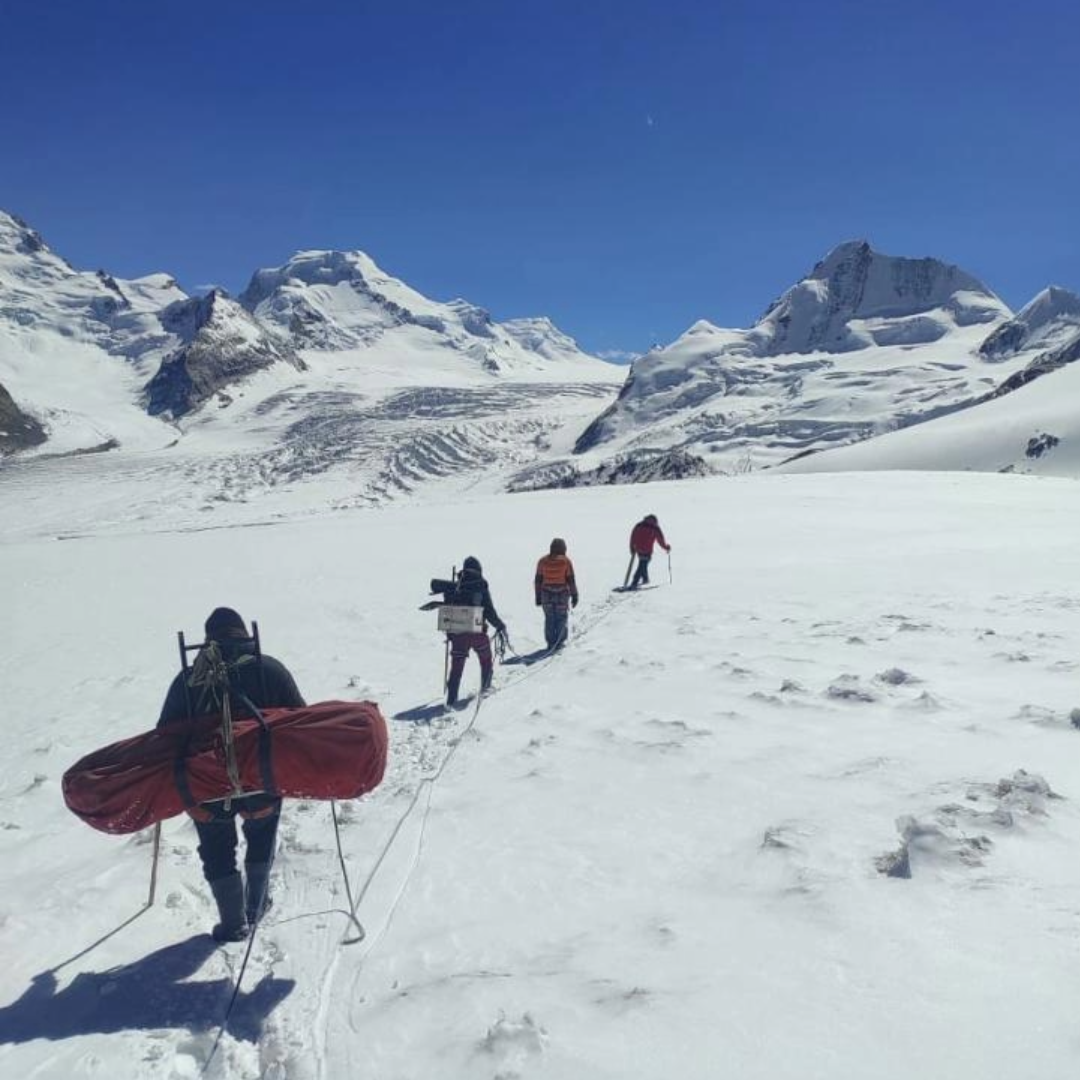
There are an estimated 54,000 glaciers in the Hindu Kush Himalayas. These glaciers cover 60,000 square kilometers and serve as a major source of the water in the region’s rivers, including as much as 40 percent in the Indus River system – the backbone of agriculture and food production in Pakistan, for example. But in recent decades glaciologists – those who study glaciers – are concerned with how Himalayan glaciers are melting, and what that could mean for the more than a billion people downstream who depend on these glaciers for agriculture, fresh water, energy production.
Smriti Srivastava is a Wilkes Center Postdoctoral Research Associate in the School of Environment, Society & Sustainability at the University of Utah. She has studied Himalayan glaciers throughout her academic and research career, which has included several field expeditions to study the glaciers up close.
(Featured image: Smriti Srivastava’s photo of her research team led by Prof. Mohd. Farooq Azam, with the Indian Institute of Technology Indore, while hiking the Drang-Drung Glacier at 5300 m a.s.l in September 2023, one of the largest glaciers in the Himalaya-Karakoram mountain range. Photo credit: Himanshu Kaushik)
Listen to the Interview:
Transcript:
Ross Chambless
Smriti Srivastava, welcome to the Wilkes Center.
Smriti Srivastava
Thank you. Thank you for having me here.
Ross Chambless
Let me ask you just to describe your research. How did you end up here? Why did you become a scientist?
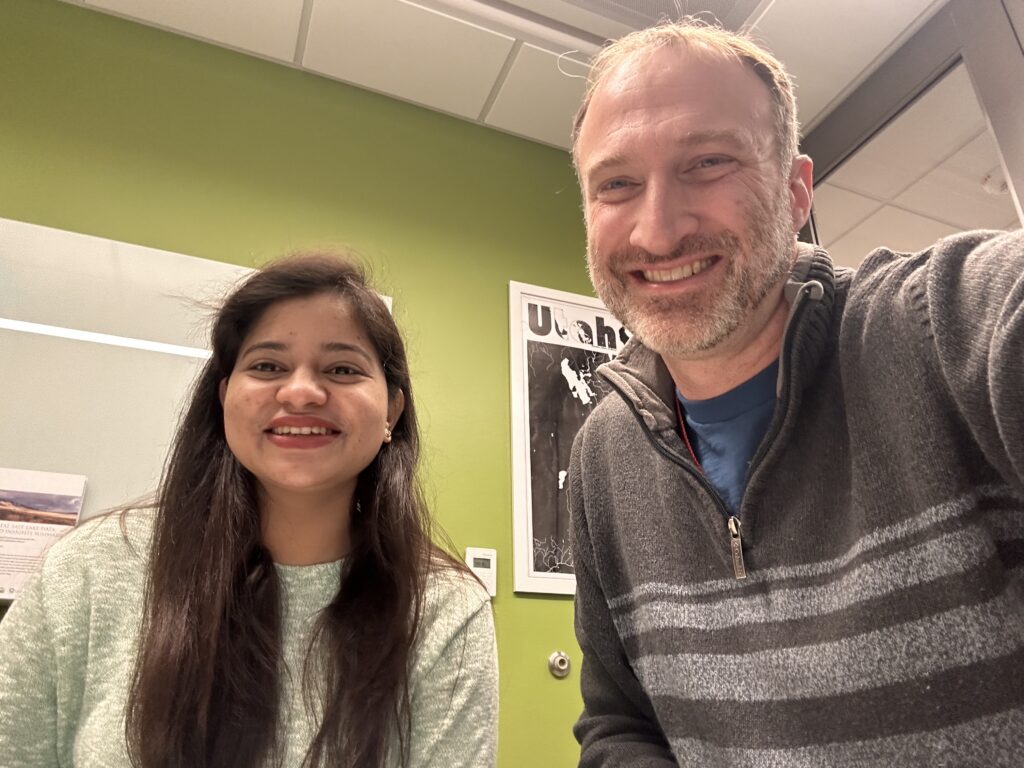
Smriti Srivastava
Yeah. Basically, I’m an interdisciplinary glacial hydrologist. I mainly integrate remote sensing, modeling and field glaciology in order to research more about Himalayan glaciers, where I’m kind of learning about the mass balance and hydrology of some specific glacierized catchments, specifically in Himalayas.
So, ending up here is a big story. It started it got started when I was in an undergraduate course. I was doing my undergraduate and I was very much interested in research. And I thought of applying and doing some internships during my summer break. So, I ended up applying to some research internships which was there in India. And then luckily, I got placed in the cryospheric section in the Indian Space Applications Centre, where I got exposed to cryospheric sciences for the first time. And I got really fascinated by seeing the glaciers on these satellite images.
And from there it begins. I did a two-month internship there on basically exploring remote sensing for the glacier velocity estimation. That was my third year. So, I had one more year. So, I applied again for an internship in the same line, and then ended up having getting work in glacial lakes. So now at that time this fascination has become kind of passion. And then I did my master’s project focusing on snowmelt runoff modeling, and then I pursued my PhD on the glacier hydrology of the Himalayan catchment. So eventually, it kind of shifted from fascination to passion. And then I’m pursuing now my postdoc on the Himalayan glaciers. So, this is how all it started and going on.
Ross Chambless
Wow. That’s quite the journey. So, growing up in India, did you go to places where there were glaciers much?
Smriti Srivastava
I think not in my early ages, but definitely during my Ph.D. Once I got fascinated by glaciers, I got an opportunity, like four or five times, to visit the field expeditions where we were researching about the Himalayan glaciers. And that actually changed my whole perspective. Before that, I was more into the modeling and remote sensing aspect. But once I was in the field, I got to know about the challenges and it really changed my perspective regarding the field glaciology stuff. So, I was interested in glaciology, but that has become a key point for driving me towards more into field glaciology aspects and realizing the importance of the challenges. What we face in the field of glaciology, and why it is so much important to study that.
Ross Chambless
I see. So, then your journey has taken you here finally to the to the University of Utah and you’ve embarked in the Wilkes Center Fellowship as a postdoc. Can you describe your current research?
Smriti Srivastava
Yeah. So, I’m very thankful first of all to the Wilkes Center for providing me research support for two years. Basically, in my current project, what I’m doing is since over the Himalayas we have very limited in situ data. And I was involved in hydrological modeling since my Ph.D. So right now, I am exploiting or looking into more high-resolution remote sensing products such as synthetic aperture radar datasets, (SAR) datasets, that could be used for the calibration of the hydrological models. Since we don’t have much in situ data, that could be an alternative for the calibration and for the estimation of reliable estimates of runoff estimates for the Himalayan catchments. So, this is what I’m specifically looking at now.
Ross Chambless
Okay. Let’s dive into that a little bit. Why, from your perspective, are the Himalayan glaciers right now important to study?
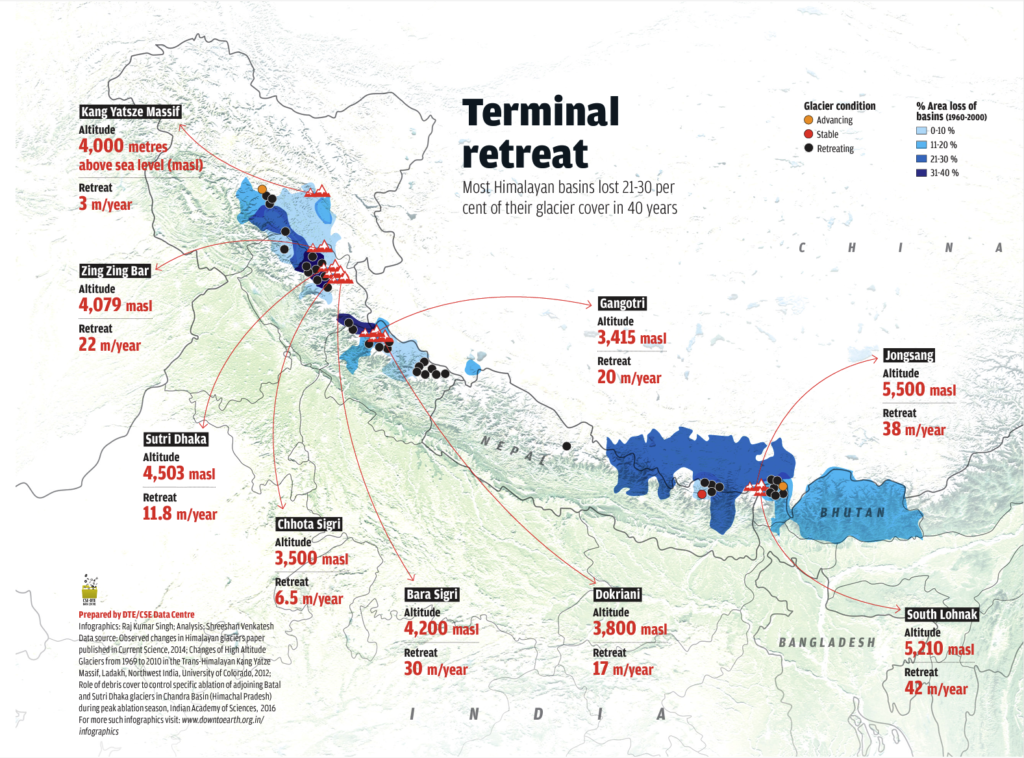
Smriti Srivastava
Yeah, definitely. The Himalayan glaciers are very much important because around a billion of people – one billion people – are living in the downstream of these Himalayan rivers. Around SIX lakh of area [600,000 sq. km] is irrigated from the water which is coming from these huge basins.
And we have a lot of hydropower generation. So according to the stats, around 27,000 megawatts are coming from the hydropower which is installed in these river basins. So, I feel like the agriculture hydropower generation, energy generation and the people who are living downstream make these Himalayan glaciers much more important to study.
Ross Chambless
Definitely. You mentioned like over a billion people. So, India, Pakistan, Nepal, Bhutan, China in this region. Like you said, hydropower energy, but also agriculture, drinking water, all these societies there depend on it.
Smriti Srivastava
Yeah, definitely. People specifically from South Asian countries such as India, Pakistan, Nepal, Bhutan, China, they are highly dependent on the water which is coming from these rivers. In fact, I’m from an area where we have a river called Yamuna, and that is also coming from Ganges, which is one of the major river basins from these Himalayan basins. So, I would say in my hometown also a lot of people are dependent from the water, which is coming from these river basins for their day-to-day needs. So, and in the same manner, a lot of people in these countries are dependent on these water rights. So that’s why the study of these and the preservation of these river sources, or water sources, is very much needed.
Ross Chambless
So then how has this region been changing over the past several decades in terms of precipitation, temperature, the integrity of these glaciers?
Smriti Srivastava
So, if you see the lake estimates from the last few decades. So, what I what the data shows is that the temperature patterns are significantly changing, the temperature are getting warmer and warmer in all these regions. However, the precipitation patterns are not changing that significantly in some parts of the Himalayas. However, that has shown a significant decrease in several other parts of the Himalayas, such as for Ganges and for these basins, the precipitation pattern has changed a lot. So, over the several decades, especially after the 20th and 21st Century, there has been a lot of changes and which are clearly visible now.
Ross Chambless
And in your research has touched on seeing how these glaciers are losing mass. Some of them are compared to how, you know, the kind of the way they were in past, in the past. And also, that, like you said, precipitation may not be changing necessarily in all places, but I mean, snowfall differences?
Smriti Srivastava
Yeah, basically my whole Ph.D. was talking about the two benchmark glaciers in the Himalaya. So, what we did is we selected two glaciers from different regions in the Himalaya. One is like the more snowfall-dominant region and other one is like kind of more monsoon-dominated region. And what we observed, we did the mass balance modeling, long-term mass balance modeling and hydrological modeling for these glacier ice catchments in order to see how it’s changing. What we observe is that from 1950 to 1980, there was positive mass balances, so there was not much warmer temperature also, and the precipitation was also higher. But since after 1990, it has started showing kind of a moderate temperature, moderate glacial wastage. But after like 2000, it significantly accelerated I would say. And after 2010, it has increased tremendously. So, in that you are getting a lot of warmer temperature, a much higher temperature, and also the precipitation has decreased particularly in these two glacierized catchments.
Also, in terms of we do hydrological modelling, where we do the estimation from climate variables, but we do area changes, like how the area of the glacier is changing, how the snow is changing. In terms of that also, these two glaciers are showing deglaciation or retreat over these recent decades. Especially after 2010, there has been a significant, significant decrease.
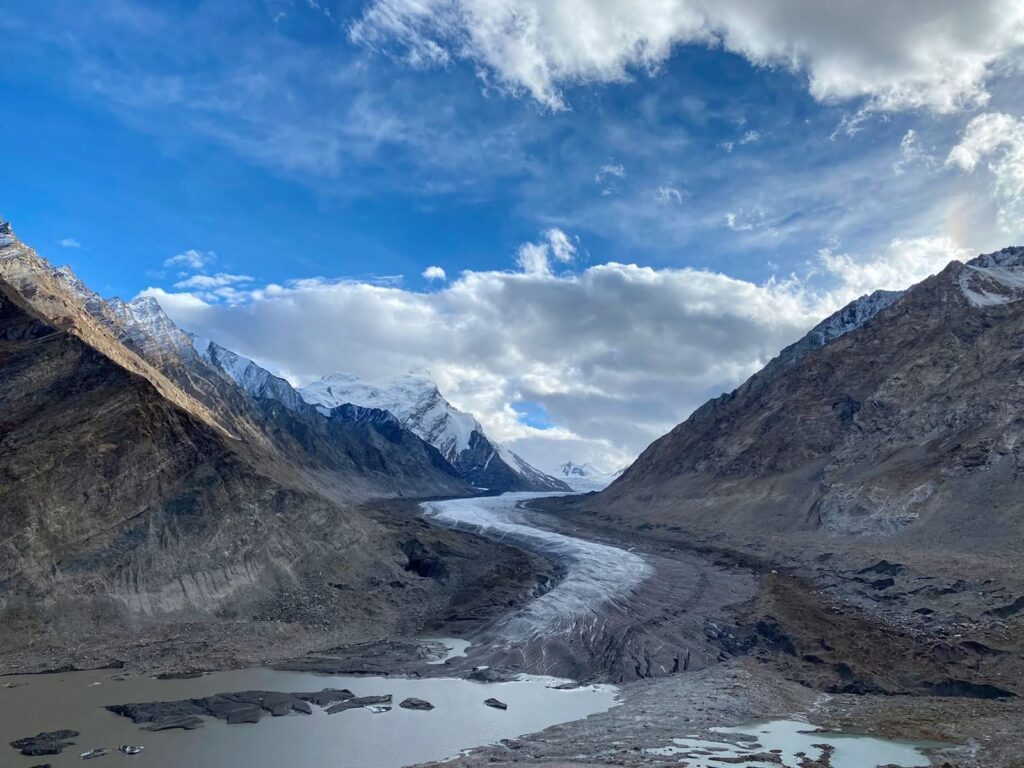
Ross Chambless
So deglaciation or retreat. Essentially the glaciers are melting smaller?
Smriti Srivastava
Yeah.
Ross Chambless
Right. And then, I understand that part of your research has also been focused on targeting the gaps, the research gaps as far as what are the areas that we don’t fully understand. What do we need to understand better.
Smriti Srivastava
Right. I feel like when I started my PhD, I worked with a group of people where we were doing a review of the main challenges in the glacier hydrology of the Himalayan glaciers. And we figured out some of the research gaps, which were that we don’t have long term mass balance and run-off series in the Himalaya. Like, how the mass balance is changing, how they were in the past, how they are going to be in the future. So, these kind of long-term series were missing in the Himalayas.
Also, the precipitation pattern over the Himalayas is very erratic. It’s very different in different regions, and we don’t have much gridded products or high altitude AWS (Automatic Weather Stations) for predicting these precipitation patterns. So, we definitely don’t have very good knowledge about how the precipitation patterns look like over the Himalayas.
Also, we have estimates of glacial mass, a glacial area, and the volume from different inventories. Like different groups of people have estimated different glacial areas, volumes and Himalaya, and they’re very different from each other. So, it’s like a lot of uncertainty in those estimates also. So, these were the few challenges which I worked on in my thesis, I tried to incorporate a couple into my thesis.
Ross Chambless
I see. How far back do recorded records go, as far as precipitation patterns in this region that are available?
Smriti Srivastava
So right now, we have a reanalysis product from ERA5. It’s from 1950 now. And we have climate models predicting precipitation until the end of the century. But these climate models are really high-resolution products. So definitely, if you estimate these at the glacier-scale, or a very small scale, they might not be very accurate in that sense. But from 1950, we have now the CDs (climate data) of temperature and precipitation, and then we used to use that climate models and long-term hydrological models in order to predict how the mass balance is changing, how the runoff of changing for Himalayan glaciers.
Ross Chambless
And so just to understand, the mass balance of these glaciers, essentially overall in net, was that they were sort of in a stabilized condition, in that they would sometimes decline or decrease and sometimes then refreeze. And it was sort of an up and down pattern, historically?
Smriti Srivastava
Yeah, definitely right. So, historically the fluctuations were very less. In fact, if you see from 1950 to current CDs, and a couple of years might be having positive mass balances where accumulation or the precipitation is more than the melting. But this has been accelerated since the 21st Century. So now, they are not in a stable state, I would say. If we talk about the past, we could say that in the historical time these Himalayan glaciers might have been in a stable state. But not now.
Ross Chambless
Well, I want to ask you about the challenges that you and others who are glaciologists, who study glaciers, what are some of the challenges in this field that you face generally?
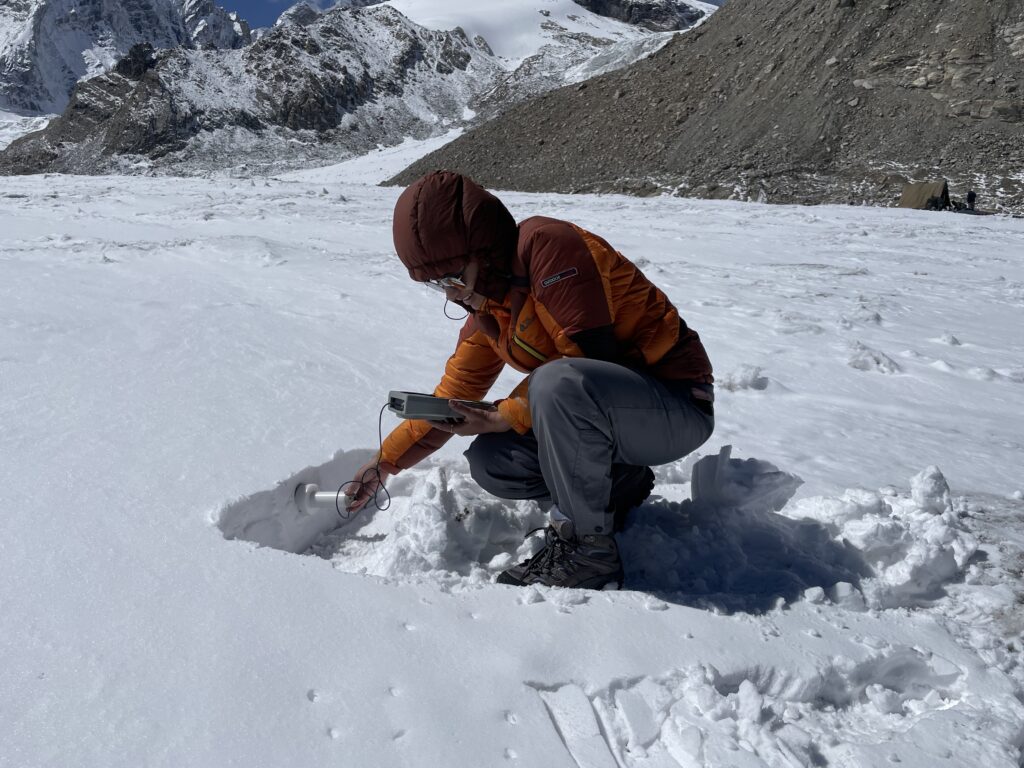
Smriti Srivastava
So, when I started doing my PhD, a lot of less female participation was there in the field glaciology. So, I would say, definitely that was also there. Not a lot of females participating in the field glaciology. But in last five years I think the government agencies and institutions, some more than the Indian government, has means has put a lot of efforts into organizing workshops to bring more people towards glaciology. Because when I thought of doing my PhD in glaciology, there were not many people doing that. But now I feel a lot of young people are interested in learning about or working on glaciers. So, it’s much more now. And specifically in South Asian countries, I would say.
Also, there are tons of challenges. If you just talk about the field of glaciology over the Himalayas, we have tons of challenges. These are very remote areas where we don’t have much Internet facilities. The area where we are camping, sometimes you have to hike for around 10 or 12 hours straight in a day to reach from one place to the base camp, or from base camp to the high camp. So, these were the challenges you have.
And sometimes if you installed some station, because you are not able to visit these areas every month or every twice a month or something like that, you install a station and by the end of the melting period and you are again visiting once the snow and everything is gone, because those roads are not accessible in peak winter seasons.
And sometimes your instruments are gone. Sometimes it stopped working midway. So you don’t have data for the whole series. Or, sometimes there is some interruption from animals, or local animals, or local people, and then you were not able to get the datasets. So, there are a lot of challenges there even reaching those particular remote areas is challenging. Definitely, you need a group to go there. You need a group of people, supportive people, I would say. Because ten or 15, like we have used to camp for 15 days or 20 days and there you need supportive people to be with you, right?
Ross Chambless
People you rely on and depend on.
Smriti Srivastava
Right. And also, it’s like the field glaciology is group work. You cannot do it alone. So, you need definitely a supportive group to do that.
Ross Chambless
Yeah. So, it sounds like there’s physical accessibility challenges – just getting to these remote sites. You mentioned not having the resources or the educational facilities or infrastructure to help students, to help young people bring more young people into the field. And you also mentioned the gender inequity. Why do you think that was?
Smriti Srivastava
I think that the field of glaciology was not very much popular at that time with students, I would say. Not only female participation, but people were not aware of it too. Students were not aware that there is a field called glaciology and they can do research about that. But I would say there have been a lot of changes in the last five years when I started my PhD, and now there are a lot of motivated people, I would say. Also, there is a lot of gender balance now. Like the government agencies and workshops are encouraging more and more women participation in these field trainings, field expeditions, and giving more exposure more to more.
Ross Chambless
Well, that seems like a positive development.
Smriti Srivastava
But yeah, definitely a positive development.
Ross Chambless
Well, just to kind of step back a little bit, you mentioned earlier that you have personal connections to this region. What are the implications of Himalayan glaciers melting away the way they are? I mean, this obviously means we have risks of flooding, but also as you mentioned the hydro-energy resources. What are some of the other implications of this?
Smriti Srivastava
Yeah. So, as I mentioned, around one billion people are dependent on the water which is coming from these rivers. I would say that a lot of people, particularly in my hometown are dependent on the water, which is coming not directly, but kind of indirectly from a small tributary to my hometown. So definitely, they have implications in both the environmental aspect, the social aspect, and you see the economic aspect. So, a lot of people are dependent on the tourism which happening in these areas. So, if there are no proper channels or proper ways to go to these tourist areas, or if there will be a lot of melting in these particular areas, a lot of tourism might decrease for them. So, a lot of people who are dependent on the income for these particular sources might be in trouble, right?
Also, I would say that these people are totally or vitally dependent on the water which is coming from these river basins. First of all, if there is water scarcity with the water coming from these river basins, that is going to directly impact their agriculture, their power needs, the hydropower generation that is happening will be cut down, right. Because of these implications, there is also a possibility of hazards also. So, there will be flooding situations there. There are GLOF events (or Glacial Lake Outburst Flood, a sudden release of a large amount of water from a glacial lake) that can occur and that can affect all the people who are living in the downstream. Right. So, because of this climate change, a lot of impacts out there on the people, which is who are living down.
Ross Chambless
Also just seems like geopolitical stability questions as well which obviously in fact can impact the entire world community. So very important issues. Very important topic. Can you talk about what impact do you hope your work will have on the state of research and helping all of us to understand the situation better?
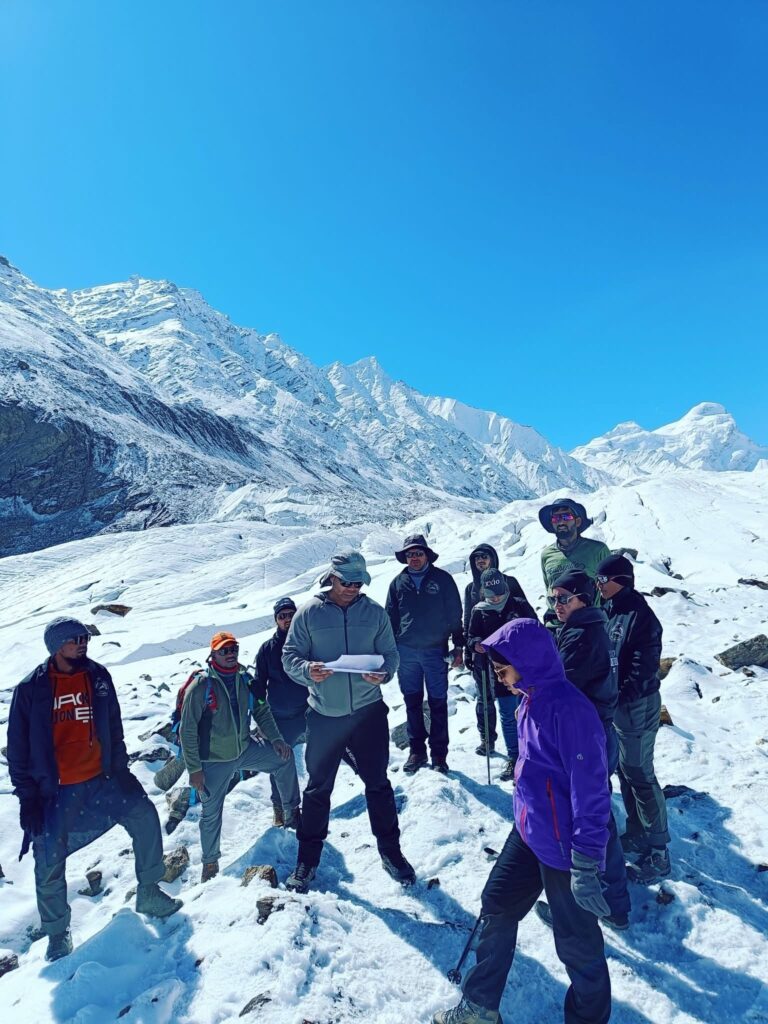
Smriti Srivastava
Basically I feel like Himalayan research is not just associated with South Asian countries. It definitely has an impact at the global level also. And through my research, firstly, I want to give some like estimates to people so that they can… like, I’m doing more of hydrological modeling. So, if I can predict the hydrological estimates for future for people who are living in these particular areas, they can be prepared and also that could be helpful in the policy making stuff also.
So, in that respect, I think this particular research work would be very useful for, especially for the people who are living there. Also, this type of research could be used for the climate resilience approach at the global level. So in in total that would be helpful for the government agencies to come up with improved policies and improved regulations so that the downstream people could benefit.
Ross Chambless
So, seemingly better understanding the problem, helping with forecasting the impacts of what may be down the line. How aware do you feel like people in these regions are of the problem right now?
Smriti Srivastava
So, here I would like to share an incident that happened last year when I visited a field expedition. So, we just halted at some place and having our break there. And there was a local guy. This was in Ladakh. And there was a local guy asking us what do you guys do? So, we told them that we are a group working on field glaciology and doing research on the Himalayan glaciers. He was very much concerned about the changes which is happening there. So, we are able to understand that even the people living in those particular areas are also very concerned and aware about what’s happening in their particular area because of the climate change.
So, I would say because of these workshops and awareness campaigns by the government, a lot of people are now involved in adapting to strategies. They might be traditional strategies. There is a mix of the strategies people are adapting. I have seen like a couple of villages that are adapting traditional conservation strategies.
Some are coming up with new scientific strategies to how to restore water coming from the glaciers and use it for future purposes. There is a concept going on for artificial stupas. Some agencies there in India, and I think non-government agencies, are creating artificial stupas, like creating artificial structures of the glaciers. So, once it’s kind of that situation occurs, those stupas could be helpful for feeding the needs of people living in the downstream areas. So certainly, there is a lot of efforts by the government agencies in this regard.
Also I think it varies from village to village. Some are progressing fast in that particular manner, some are still slow in that particular aspect, depending upon how the government is taking initiative in that particular area, and how the people are getting educated also. But definitely a lot of improvement in that regard. And I think in coming years there will be more into this particular aspect.
Ross Chambless
So, what gives you hope with this topic? I mean, it’s a daunting subject, but at the same time, you said that there are improvements happening and people are concerned and people are focusing more on this topic.
Smriti Srivastava
Yeah, so I feel like I’ve been in this field from last 8 to 9 years now. I started as an undergraduate student, then did my master’s, and then Ph.D., and now a postdoc. So, in the last seven, eight years, I have seen a lot more people are getting educated in that particular aspect. A lot of people are coming into this field to help, to study in the terms of research work, in order to open non-government institutions, in order to help people. So, a lot of development is definitely happening. And that gives me hope.
And in terms of on a personal level, and at the government level, a lot of efforts are being taken by the institutions and the government agencies. There are a few institutions such as ICIMOD (International Centre for Integrated Mountain Development). They are doing great in educating people, organizing workshops, doing awareness campaigns for people who are living in the downstream areas. So, they should be like prepared for that particular situation that is going to happen in the future. So yeah, much more efforts coming from everywhere gives me hope, and definitely and I just hope that my research somehow helps people who are living downstream for the future.
Ross Chambless
Well, that’s good to hear. Finally, what do you do when you’re not doing research? What do you do for fun?
Smriti Srivastava
That’s a very tough question for me, because I am mostly involved in my research most of the time. I do a lot of cooking since I’m in U.S. And then since I’m living away far from my family, I want to spend some time with them. I used to spend my time with them, living with them, or chatting with them. I do that.
Ross Chambless
It’s hard to be away from home and family.
Smriti Srivastava
If I get some time, I want to spend with them. I go on trips with them. And I do like a bit of hiking too.
Ross Chambless
Well, hopefully your, your experience here and your time here at the University of Utah at the Wilkes Center will be fulfilling. But we’re just so happy to be able to have this opportunity to work with you for this for the coming years or so. I want to thank you, Smriti, for joining me and talking and sharing your research.
Smriti Srivastava
Yeah. Thank thanks a lot for having me here. And just I wanted to say something in the conclusion. I would say that definitely these Himalayan glaciers are melting at a rate that is concerning for the agencies and for everyone. But I would also say that we should calm down, we should sit down, and look for those solutions which are more local approaches that will be more needed and more reliable in this situation.
Ross Chambless
thank you so much.